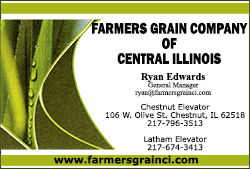|
 Making the transition to grow an organic corn or soybean crop
requires time and patience, plus some fundamental changes in farming
techniques. Making the transition to grow an organic corn or soybean crop
requires time and patience, plus some fundamental changes in farming
techniques.
The land will need to be farmed according to new national standards
such as not using synthetic chemicals as pesticides and fertilizers,
and not planting genetically modified seed.
Going organic requires a long term strategy because you will need to
learn production standards, develop a transition strategy, find
potential markets for products, keep detailed records, apply for
certification, and become officially certified.
The process for land to become organically certified takes three
years and there are several standards that must be followed.

The USDA states organic crop production standards require that :
- Land must have had no prohibited substances applied to it
for at least three years before the harvest of an organic crop.
- Soil fertility and crop nutrients will be managed through
tillage and cultivation practices, crop rotations, and cover
crops, supplemented with animal and crop waste materials, and
allowable synthetic materials.
- Crop pests, weeds, and diseases will be controlled primarily
through management practices including physical, mechanical, and
biological controls. When these practices are not sufficient, a
biological, botanical, or synthetic substance approved for use
on the National List may be used.
- Operations must use organic seeds and other planting stock
when available.
- The use of genetic engineering, ionizing radiation and
sewage sludge is prohibited.
Starting the process of becoming organically certified requires
specifically documenting the last time prohibited materials were
used. Compost, animal manure, and green manure are some of the
fertilizers that may be used in the place of synthetic
fertilizers.
Atlanta's PrairiErth farms, owned by the Dave Bishop family, has
been organically certified for a few years. In the farm's
fertilization processes, "We use compost as fertilizer and all
of the compost comes directly from our farm. Whether it be
manure or vegetable waste, it breaks down for a season, then is
spread on the field in the following spring. We also use cover
crops, also known as green manures. These crops are grown for
the sole purpose of what they return to the soil when they are
then tilled under."
The health of the soil is very important for growing organic
crops. In the article "Time to Transition Your Farm to Organic,"
Illinois Stewardship Alliance's Conservation Associate, Woody
Woodruff says, "One of the underlying principles of organic
farming is the building of healthy soils with good structure,
high organic matter, diverse soil micro and macro fauna, and
high water-holding capacity."
The Guidebook for Organic Certification published by the Midwest
Organic and Sustainable Education Service (MOSES) says, "Organic
farmers don't substitute 'approved' inputs in place of synthetic
fertilizers and pesticides. Rather, organic farmers continuously
improve their farm system by building and balancing soils..."
With all the changes during the transitional period, patience is
needed. As Tom Doran, a field editor for Agrinews says, "Getting
through those first two years of transitioning to organic is a
challenge."

Harold Wilken switched over to organic production at his farm
near Danforth several years ago and describes some challenges.
Wilken says, “You really have to tighten your belt in those two
years because you are getting conventional prices and farming
organically. But nowadays the costs of conventional farming are
so high that actually going into transition isn’t as bad as it
used to be."
Several other measures need to be considered when making a
transition to organic farming. The USDA says organic operations
must implement preventive practices based on site-specific risk
factors, such as neighboring conventional farms or shared farm
equipment or processing facilities.
The organic system plan documents several measures. For example,
organic farmers must plant "early or late to avoid organic and
GMO crops flowering at the same time" due to risks of
"cross-pollination."
Communication with conventional farmers is beneficial. The USDA
says it may be helpful to "sign cooperative agreements with
neighboring farms to avoid planting GMO crops next to organic
ones."
Some organic farmers may "... designate the edges of their land
as a buffer zone where the land is managed organically, but the
crops aren’t sold as organic."
It is also important to "Thoroughly clean any shared farm or
processing equipment to prevent unintended exposure to GMOs or
prohibited substances."
Good record keeping is another important part of the transition.
The Illinois State Department of Agriculture shows a list of
information required to become organically certified, such as by
showing "substances applied to land for the previous three
years" and "Organic products being grown, raised, or processed."
The applicant's organic plan, must show "practices and
substances used in production" and "describe the monitoring
practices to be performed to verify that the plan is effectively
implemented." It should also detail "the record-keeping system,
and the practices to prevent commingling of organic and
non-organic products and to prevent contact of products with
prohibited substances."
The transition from traditional to organic also means finding a
market for products, but that may be less challenging. As
organic products have become more popular, there are more
markets for these products, and sales have increased in recent
years. Organic grains for livestock and poultry feed capture a
premium price.
In today's increasingly health conscious society, the market for
organic products is growing along with plenty of informational
resources. Grocers and other consumer markets carry an expanding
line of organic products.
Though the transition and implementation may be challenging, the
change may be beneficial to those who may want more control over
input costs and market options.
According to the University of Illinois Extension, "Growing
organic grain is an emerging trend in agriculture. An increasing
number of farmers realize that gaining control over their
marketing, and tapping into the strong demand for
identity-preserved organic grain has many benefits."
Organic crops show higher profits
Certified organic crop acres more than doubled between 2002 and
2011, and that trend continues today. Of the then over 3 million
acres certified organic, 264,000 crop acres were in corn,
soybean and wheat.
As organic production interests increase and new local markets
emerge, organic crops are offering new opportunities to the
farmers.
Experts find it challenging to report and project just how much
profit might be realized by turning to organic, as records
currently only offer "limited time-series data."

[to top of second column] |
 The USDA put together a report in 2015 based on an Agricultural
Resource Management Survey (ARMS) that was conducted of targeted
organic farms.
The economic analysis examined only operating or variable costs. It
excludes the economic costs of land, labor and capital. Mean figures
were used that also incorporated transition to becoming certified
organic costs. Organic production figures are expected to continue
to change for the better.
Summarized high points from the 2015 study:
- Significant price premiums paid for certified organic crops.
- Additional economic costs of organic versus conventional
production were more than offset by higher returns from organic
systems for corn and soybeans, although not for wheat.
- Organic field crop production was, on average, conducted on
farms with less total acreage and less field crop acreage than
conventional farms.
- Despite having fewer acres, producers of some organic field
crops were less likely to work off-farm. These producers were
also more likely to have attended college than conventional
producers.
- Most organic producers used mechanical practices, such as
tillage and cultivating for weed control.
- Organic corn and soybean producers more often rotated row
crops with small grain and meadow crops and often included an
idle year in the rotation.

- Experimental research on organic field crop production has
found similar yields and lower per-acre costs from organic
relative to conventional field crop production.
- Observational study of commercial organic and conventional
field crop production found lower yields and mostly higher
per-acre total economic costs from organic systems.
- As in much of the economic analyses using experimental data,
per-bushel operating costs of organic relative to conventional
systems were similar in this study. However, the per-bushel
economic costs of organic production were significantly higher
because of the higher per-acre costs and lower yields.
The economic costs of organic compared with conventional
production estimated in this study were roughly between $83 and
$98 per acre higher for corn, $55-$62 per acre higher for wheat,
and $106-$125 per acre higher for soybeans. These estimated cost
differences are all higher than those suggested by the relative
means.
Results of this study conclude, "some conventional farms
may be able to earn greater returns if transitioned to organic
production."
Researchers observed: "adoption of the organic
approach among U.S. field crop producers remains extremely low,
the report surmised that, "perhaps a key factor is that organic
field crop production is particularly challenging compared with
conventional production in achieving effective weed control and
crop yields.
"The processes involved with organic certification can be
complex and time-consuming."
----- Additional economic research and analysis
figures in 2015 show organic corn and soybean production had
higher returns than traditional corn and beans.

Click on image
for larger version
Organic production costs are higher than conventional costs, but
higher prices received for organic crops more than offset the
higher costs for organic corn and soybeans, although not for
organic wheat.

|
Difference between
organic
and conventional |
|
Crop |
Economic costs
($ per bushel) |
Economic costs
($ per acre) |
Returns above economic costs
($ per acre) |
|
Corn |
1.92
to 2.27 |
83
to 98 |
51
to 66 |
|
Wheat |
3.90
to 4.46 |
55
to 62 |
-9
to -2 |
|
Soybeans |
6.62
to 7.81 |
106
to 125 |
22
to 41 |
Source: USDA, Economic Research Service
calculations using Agricultural Resource Management Survey data
and include production cost differences plus organic transition
and certification costs. The range of costs and returns was
generated from alternative statistical methods.
While organic wheat
profitability remains low, field to table marketers are excited
by new hybrid wheat with higher nutrient and protein values, as
well as plans to develop hub (localized) stone grinding. Wheat
would likely gain a new standing in the local organic feed and
food markets and become profitable in the near future.
Resources:
|